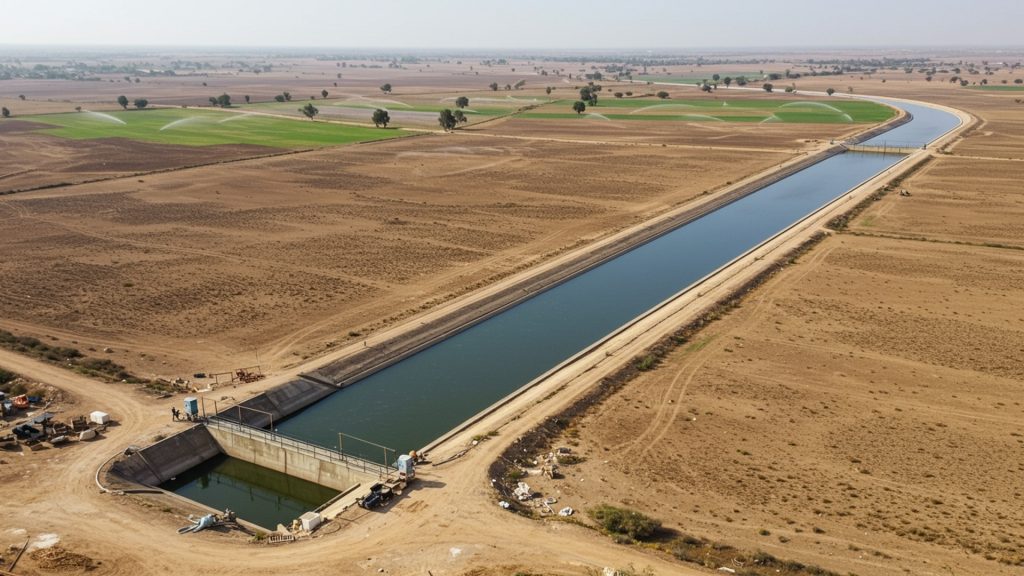Rajasthan now declares water self-sufficiency its highest aim, making it the state’s main focus. Facing a long history of severe water shortages, this crucial move comes as many areas struggle with not having enough water for daily needs. The state government announces a big new plan to ensure every home and farm receives a steady water supply. This bold promise marks a turning point, pushing Rajasthan towards a future where it controls its own water resources, a vital step for its people and dry lands.
Understanding Rajasthan’s Water Challenges
Rajasthan, India’s largest state by area, faces a deep and ongoing challenge with water availability. Despite its vast geographical size, covering 342. 52 lakh hectares, which is about 10. 4 percent of the country’s total land area, Rajasthan holds a very small share of India’s water resources. It possesses only 1. 16 percent of the nation’s surface water and 1. 72 percent of its groundwater. This imbalance means the state experiences severe water shortages, with only 1. 15 percent of India’s total water resources being available to support its large agricultural population.
The problem is made worse by several factors. Groundwater levels across the state have fallen sharply, with many water blocks now classified as over-used or in critical condition. Data from 2024 shows that Rajasthan extracted 17. 05 Billion Cubic Meters (BCM) of groundwater. only 11. 37 BCM was recharged naturally. This has led to a significant drop in the number of ‘safe’ groundwater blocks, from 203 in 1984 to just 37 in 2024. More than half of the state’s drinking water needs are met by groundwater. increasing demand, coupled with shrinking surface water sources and illegal building on catchment areas, deepens the crisis.
Cities like Jaipur, which are growing fast, have faced very limited access to government-supplied water, sometimes for as little as one hour a day. Beyond quantity, water quality is also a serious concern. As of April 2024, about 4. 20 lakh households, affecting 24. 52 lakh people, suffer from water contamination due to high levels of salinity, fluoride. nitrate, largely caused by excessive groundwater use. The unpredictable rainfall patterns due to climate change, along with pollution and too much extraction of groundwater, are the main reasons behind this severe water problem.
Making Water Security a Main Goal
In response to its critical water situation, Rajasthan has declared that achieving water self-sufficiency is its most crucial goal. Chief Minister Bhajan Lal Sharma recently stated that ensuring the state has enough water on its own is a top priority. This commitment is supported by the Union Jal Shakti Minister, CR Patil, who expressed strong belief that Rajasthan can become a state with plenty of water under current leadership. This aim involves working together between the central government and the state government.
This pledge marks a new push in the state’s long-standing efforts to manage its precious water resources more effectively. The government is not only focusing on large-scale projects but also on community involvement, recognizing that the combined efforts of all people are needed to make a real difference. The goal is to move from a state of constant water shortage to one where water resources are managed sustainably for all uses, including for people, animals, farming. industry.
Main Actions for Water Savings
To make Rajasthan self-sufficient in water, the government has launched several crucial programs and initiatives. These plans aim to tackle the water shortage from different angles, using both modern and traditional methods of water management.
Water Conservation Campaign
A major step was the launch of a two-week water conservation campaign on World Environment Day, June 5, 2025. This campaign focuses on several key areas:
- Bringing back traditional water sources to their original good condition.
- Building new structures to collect rainwater.
- Recharging underground water supplies.
- Repairing existing dams and canals.
During this campaign, plans for water conservation projects worth 345 crore rupees will be started. The government has also committed to building at least 125 water conservation structures in every district.
Mukhyamantri Jal Swavalamban Abhiyan (MJSA)
The Mukhyamantri Jal Swavalamban Abhiyan (MJSA) is a very crucial program. It was first started on January 27, 2016, with the aim of making over 21,000 villages in Rajasthan self-reliant in terms of their water needs by 2020.
The program is based on a “Four-waters Concept” which includes collecting and managing rain water, groundwater, underground water. moisture in the soil in rural areas. It involves treating water catchment areas, proper use of water. building or fixing water harvesting structures.
The first phase of MJSA showed good results, leading to an average rise of 4. 66 feet in the water table in 21 districts that are not deserts. It also led to a 56. 13 percent drop in water supply through tankers and helped bring back to life 63. 64 percent of hand-pumps that were not working. Looking ahead, MJSA 2. 0 plans to build 500,000 water harvesting structures in 20,000 villages over the next four years, with a budget of 11,200 crore rupees.
Eastern Rajasthan Canal Project (ERCP)
The Eastern Rajasthan Canal Project (ERCP) is another large-scale effort. It was first thought of in 2017 to use extra monsoon water from the Chambal river basin and its smaller rivers like Kalisindh, Parvati, Mej. Chakan. The goal is to move this extra water to 13 districts in eastern Rajasthan that do not have enough water. The project aims to provide drinking water, water for industries. water to irrigate about 2. 82 lakh hectares of land. It is also expected to supply water to the Delhi-Mumbai Industrial Corridor.
The updated Parbati-Kalisindh-Chambal (PKC)-ERCP project is now part of India’s bigger River Linking Projects. This modified plan will cost over 80,000 crore rupees and will improve water availability for 17 districts. The central government will pay 90 percent of the 70,000 crore rupees needed for the Revised PKC Link Project (Integrated ERCP), with the state governments paying the remaining 10 percent.
Other crucial Programs
Besides these main projects, Rajasthan is also part of other national water efforts:
- Atal Ground Water Scheme: Started on April 1, 2020, this scheme aims to stop groundwater levels from dropping. It is carried out with the World Bank, sharing costs equally.
- State Water Policy (2010): This policy sets clear rules for how water should be used, giving top priority to human drinking water, followed by water for animals, general household use. then farming.
- Jal Jeevan Mission: This national program aims to provide tap water connections to 100 percent of households by 2028.
- Jal Shakti Abhiyan: This is another essential national campaign focused on water conservation and water security.
In addition, the Rajasthan State Industrial Development & Investment Corporation (RIICO) has made it a rule that all plots larger than 500 square meters must have rainwater harvesting systems installed. The Rajasthan Police Housing and Construction Corporation Limited (RPH&CCL) will also add rainwater harvesting to its ongoing building projects.
Community Involvement and Ways Forward
The Chief Minister has stressed the importance of public participation in all water conservation efforts, calling it a moral duty to protect nature. He highlighted that people in Rajasthan have always used special ways to save water, such as stepwells, ‘johads’ (village ponds). other traditional structures, which are still crucial examples of water conservation. The government is actively working to bring back and use this old wisdom alongside new technologies.
Local communities are seen as key players in making water projects successful. For example, in the Sikar district, a project involving a partnership showed how community ownership, with families giving money, work, or land. women trained as engineers, can lead to lasting improvements in water access and farming. Such community efforts are vital for ensuring that water management plans are effective and truly meet the needs of the people. By combining old wisdom with new methods, Rajasthan hopes to build a more secure water future for everyone.

